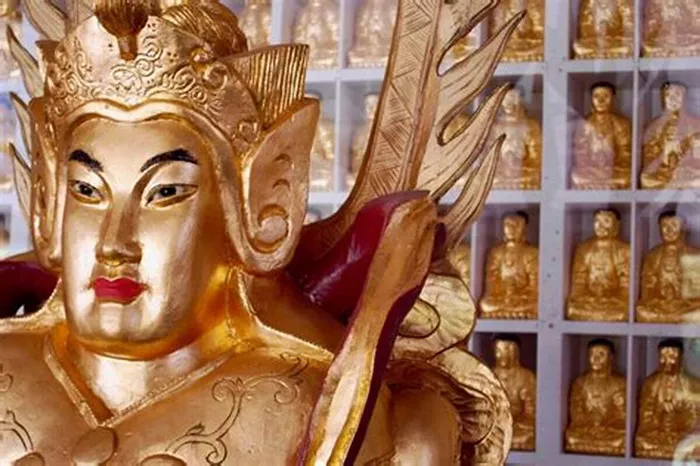Mahayana Buddhism is one of the two main branches of Buddhism, the other being Theravada. It began around the 1st century CE and spread widely in East Asia. Mahayana means “Great Vehicle,” symbolizing a broad path that seeks to help all beings reach enlightenment. This branch emphasizes compassion and wisdom, aiming for Buddhahood rather than just personal liberation.
Understanding Leadership in Mahayana Buddhism
Unlike some religions with a single, centralized leader, Mahayana Buddhism does not have one official head or pope. Instead, its leadership is shared among great teachers, monks, and spiritual masters across different countries and traditions. Leadership in Mahayana comes from those who deeply understand Buddhist teachings and guide others on the path.
Main Leaders in Early Mahayana History
The Buddha
At the core of all Buddhism, including Mahayana, is the historical Buddha, Siddhartha Gautama. Although he lived over 2,500 years ago, his teachings form the foundation. In Mahayana, the Buddha is seen not just as a teacher but as a cosmic figure, often called the Dharmakaya (truth body), embodying ultimate reality.
Nagarjuna (c. 150–250 CE)
Nagarjuna is one of the most important philosophers in Mahayana Buddhism. He founded the Madhyamaka school, which teaches the “Middle Way,” focusing on the concept of emptiness (śūnyatā). Nagarjuna’s works deeply influenced Mahayana thought, especially on wisdom and understanding reality.
Asanga and Vasubandhu
These two brothers were key figures in developing the Yogacara school of Mahayana. Their teachings focus on the mind and consciousness. They explained how our perception shapes reality and emphasized practices to transform the mind toward enlightenment.
Great Bodhisattvas as Spiritual Leaders
In Mahayana, Bodhisattvas are enlightened beings who choose to stay in the world to help others achieve enlightenment. Some Bodhisattvas are revered as spiritual leaders and symbols of ideal qualities.
Bodhisattva Avalokiteshvara
Avalokiteshvara, also called Guanyin in East Asia, is the Bodhisattva of compassion. He is seen as a leader in helping beings through suffering. Many Mahayana Buddhists pray to Avalokiteshvara for mercy and guidance.
Bodhisattva Manjushri
Manjushri represents wisdom and is considered a spiritual guide who helps people develop insight. He is often depicted holding a sword that cuts through ignorance, symbolizing clear understanding.
Bodhisattva Ksitigarbha
Ksitigarbha is known for his vow to help beings in hell realms and all suffering places until everyone is free. He is respected as a leader who shows great compassion and determination.
Modern Mahayana Buddhist Leaders
Today, Mahayana Buddhism includes many traditions such as Zen, Pure Land, and Tibetan Buddhism. Each has its own teachers and leaders who guide followers.
Zen Buddhism Leaders
Zen Buddhism focuses on meditation and direct experience. Important Zen masters, both historical and modern, are considered leaders. For example:
- Bodhidharma — Traditionally credited with bringing Zen to China.
- Huineng — The Sixth Patriarch of Zen in China, famous for teaching sudden enlightenment.
- Modern leaders like Thich Nhat Hanh — A Vietnamese Zen master known worldwide for mindfulness teachings.
Pure Land Buddhism Leaders
Pure Land Buddhism is very popular in East Asia. It teaches devotion to Amitabha Buddha to be reborn in the Pure Land, a place ideal for enlightenment. Key leaders include:
- Shandao — A great Chinese Pure Land master who systematized Pure Land practice.
- Honen — Founder of Pure Land in Japan.
- Shinran — A Japanese disciple of Honen who expanded Pure Land teaching.
Tibetan Buddhism Leaders
Tibetan Buddhism is a form of Mahayana combined with Vajrayana teachings. It has clear hierarchies and recognized spiritual leaders, including:
- The Dalai Lama — The most famous Tibetan leader, regarded as the spiritual leader of Tibetan Buddhism and a symbol of compassion worldwide.
- The Panchen Lama — Another important figure in Tibetan Buddhism, involved in religious education and leadership.
- Other Lamas and Rinpoches — Respected teachers who lead monasteries and guide practitioners.
How Mahayana Leaders Guide Followers
Mahayana leaders teach the path of the Bodhisattva, emphasizing helping others while seeking enlightenment. Their guidance often includes:
- Teaching Buddhist philosophy and meditation.
- Encouraging compassion and ethical living.
- Leading rituals and ceremonies.
- Offering personal advice to followers.
Conclusion
In summary, Mahayana Buddhism does not have a single leader like some religions. Instead, leadership is shared among enlightened teachers, Bodhisattvas, and respected monks. These leaders guide followers with wisdom and compassion, helping many people along the Buddhist path. Whether historical figures like Nagarjuna or modern teachers like the Dalai Lama, each plays an important role in keeping Mahayana Buddhism alive and meaningful today.

